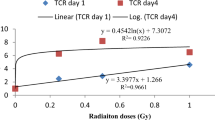Abstract
Objective
Cancer patients undergoing large dose radiotherapy exhibit multifaceted defects in their immune capacity that are likely to contribute to an increased susceptibility to infections and disease progression. The immune impairment may also constitute a barrier to effective immunotherapeutic interventions. Here, we evaluate whether supplementation with the male zooid of Antheraea pernyi extracts could enhance immune function in irradiated rats.
Methods
Fifty male Wistar rats were randomly divided into a control group, a simple radiation group and a treatment group. The mice in the simple irradiation and treatment groups were given whole-chest irradiation with 6Gy. In the treatment group, the male zooid of Antheraea pernyi extracts was gavaged at the doses of 16.53mg/kg (large dose group), 2.62mg/kg (medium dose group), and 0.564mg/kg (small dose group) once a day for 14 days. The thymus and spleen indices were calculated. T cell subsets in peripheral blood were determined by flow cytometry and the expressions of IL-2, IFN-γ, IL-4 and IL-10 in sera were determined by ELISA on the 15th day.
Results
The thymus index and spleen index of the high dose treatment group were statistically lower than that of the control group and higher than that of the radiation group (P<0.01). CD3+ and CD4+ T cells in the peripheral blood were increased in the high dose treatment group and decreased in the radiation group (P<0.01). Expression of IL-2 and INF-γ in the radiation group was lower than that in control, and significantly increased during therapy. The production of IL-4 and IL-10 could be induced by radiation and was inhibited in the high dose treatment group (P<0.01).
Conclusion
Our data indicate that the male zooid of Antheraea pernyi extracts may be administrated to improve immune function in irradiated rats and reverse the radial immune inhibition of rats by stimulating the proliferation of Th cells and inducing the differentiation of Th2 to Th1.
Similar content being viewed by others
References
Kiessling R, Wasserman K, Horiguchi S, et al. Tumor-induced immune dysfunction[J]. Cancer Immunol Immunother 1999; 48: 353–362.
Young RC, Corder MP, Haynes HA, et al. Delayed hypersensitivity in Hodgkin’s disease: a study of 103 untreated patients[J]. Am J Med 1972; 52: 63–72.
Alexander JP, Kudoh S, Melsop KA, et al. T cells infiltrating renal cell carcinoma display a poor proliferative response even though they can produce interleukin 2 and express interleukin 2 receptors[J]. Cancer Res 1993; 53: 1380–1387.
Uzzo RG, Clark PE, Rayman P, et al. Alterations in NFB activation in T lymphocytes of patients with renal cell carcinoma[J]. J Natl Cancer Inst 1999; 91: 718–721.
Kandil A, Bazarbashi S, Mourad WA. The correlation of Epstein-Barr virus expression and lymphocyte subsets with the clinical presentation of nodular sclerosing Hodgkin disease[J]. Cancer 2001; 91: 1957–1963.
Heriot AG, Marriott JB, Cookson S, et al. Reduction in cytokine production in colorectal cancer patients: association with stage and reversal by resection[J]. Br J Cancer 2000; 82:1009–1012.
Kuss I, Saito T, Johnson JT, et al. Clinical significance of decreased chain expression in peripheral blood lymphocytes of patients with head and neck cancer[J]. Clin Cancer Res 1999; 5: 329–334.
Schwarz T. Mechanisms of UV-induced immuno-suppression[J]. Keio J Med 2005; 54:165–171.
Abbas AK, Murphy KM, Sher A. Functional diversity of helper T lymphocytes[J]. Nature 1996; 383: 787–793.
Gajewski TF, Schell SR, Nau G, Fitch FW. Regulation of T-cell activation: differences among T-cell subsets[J]. Immunol Rev 1989;111:79–110.
Kaplan MH, Sun YL, Hoey T, et al. Impaired IL-12 responses and enhanced development of Th2 cells in Stat4-deficient mice[J]. Nature 1996; 382:174–177.
Ouyang W, Ranganath SH, Weindel K, et al. Inhibition of Th1 development mediated by GATA-3 through an IL-4-independent mechanism[J]. Immunity 1998; 9: 745–755.
Zhou M, Ouyang W. The function role of GATA-3 in Th1 and Th2 differentiation[J]. Immunol Res 2003; 28:25–37.
Szabo SJ, Kim ST, Costa GL, et al. A novel transcription factor, T-bet, directs Th1 lineage commitment[J]. Cell 2000; 100: 655–669.
Szabo SJ, Sullivan BM, Stemmann C, et al. Distinct Effects of T-bet in TH1 Lineage Commitment and IFN-γ Production in CD4 and CD8 T Cells[J]. Science 2002; 295:338–342.
Seo N, Ito T, Wang N, et al. Anti-allergic Psidium guajava extracts exert an antitumor effect by inhibition of T regulatory cells and resultant augmentation of Th1 cells[J]. Anticancer Res 2005; 25:3763–3770.
Li S, Zhang B, Zhang WD, et al. Immunization of mice with concentrated liquor from male zooid of Antheraea pernyi[J]. World J Gastroenterol 2005; 11: 4254–4257.
Zhao WH, Li L, Zhang B, et al.Enhancement of CD4+ T cell activities and modulation of Th1/Th2 lineage development in radiated tumor-bearing rats treated with male zooid of Antheraea pernyi extracts[J]. World J Gastroenterol 2008;14: 2094–2099.
Qu Z, Steiner H, Engstrom A, et al. Insect immunity: isolation and structure of cecropins B and D from pupae of the Chinese oak silk moth, Antheraea pernyi[J]. Eur J Biochem 1982;127: 219–224.
Zhang WM, Lai ZS, He MR, et al. Effects of the antibacterial peptide cecropins from Chinese oak silkworm, Antheraea pernyi on 1,2-dimethyl-hydrazine-induced colon carcinogenesis in rats[J]. Di Yi Jun Yi Da Xue Xue Bao(in Chin) 2003; 23:1066–1068.
Mauri C, Feldmann M, Williams RO, et al. Down-regulation of Th1-mediated pathology in experimental arthritis by stimulations of Th2 arm of the immune response[J]. Arthritis Rhenm 2003; 48: 839–845.
Yamamura M, Modlin RL, Ohmen JD, et al. Local expression of antiinflammatory cytokines in cancer[J]. J Clin Invest 1993; 91:1005–1010.
Author information
Authors and Affiliations
Corresponding author
Additional information
This work was supported by the grants from the National Natural Science foundation of China (No. 30472260), the Administration of Traditional Chinese Medicine of Shandong Province, China(No. 2005-109),, and the Health Protection Committee of Shandong Province, China(No. 2006059).
Rights and permissions
About this article
Cite this article
Zhao, B., Zhang, HY., Zhao, WH. et al. Enhanced CD3+/CD4+ T cell activities and modulation of Th1/Th2 lineage development in irradiated rats due to treatment with the male zooid of antheraea pernyi extracts. Chin. J. Cancer Res. 20, 255–261 (2008). https://doi.org/10.1007/s11670-008-0255-1
Received:
Accepted:
Published:
Issue Date:
DOI: https://doi.org/10.1007/s11670-008-0255-1




